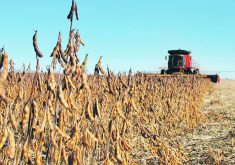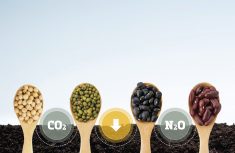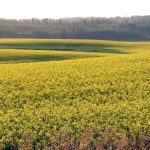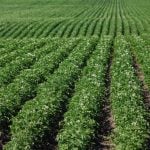It’s no coincidence that the popularity of pulse crops is rising as consumers become more interested in healthy eating, says Murad Al-Katib, president and CEO of Saskatchewan-based AGT Food and Ingredients.

“As a food industry I think we have to be prepared for what could be a transformational earthquake that is coming with consumers where there is a connection between natural and non-GMO and healthy, clean labels. And pulses give us that opportunity to look at protein, fibre… micronutrients, natural bio fortification.
“We are seeing all these trends aligning.
“When I look at the demand fundamentals from a product development standpoint and a consumer trend standpoint this is actually an irreversible trend,” Al-Katib, who is also president of the Canadian Special Crops Association, told a record crowd at the Pulse and Special Crops Convention (PSCC) here July 6. “It’s not one that I think is grounded in a fad or some type of a temporary phenomenon where we are going to see pulse consumption and ingredients rise and then potentially taper off. We are ultimately looking at a high-protein, high-fibre, non-GMO, gluten-free product, with a very strong and environmental story to tell.”
Read Also

A place of national honour for former deputy ag minister, Dori Gingera-Beauchemin
Long public service, focus on community and industry leadership launch Dori Gingera-Beauchemin into 2025 Canadian Agricultural Hall of Fame honourees
Perhaps the biggest challenge facing the industry, however, is telling its story. That’s getting easier too, once people know what they are.
Pulses are the edible seeds of plants in the legume family. Dried peas, edible beans, lentils and chickpeas are the most common. (Soybeans and peanuts are legumes, but their dried seeds are not considered ‘pulses’ because of their higher oil content.) Pulses are high in protein and fibre and low in fat. As well, they are nitrogen-fixing crops that improve the environmental sustainability of annual cropping systems.
Canada, the world’s largest pulse exporter in the world, is expecting a record pulse harvest this year.
Despite a depressed stock market and low commodity prices, the future demand for pulses is huge, said Peter Hall, vice-president and chief economist with Export Development Canada. The U.S. economy is growing and so is China’s, along with its middle class and that of India’s, he said.
A record 530 attendees, including more than 140 from 24 different countries, attended the convention. With Canadian pulse exports on the increase people came to the meeting to see what’s happening, said Gordon Bacon, president of Pulse Canada and CEO of the Canadian Special Crops Association.

“This is our biggest convention ever,” Bacon told reporters. “It is the biggest sponsorship we have ever had. This is the biggest number of international delegates that we have ever had. I think it is all saying what we’ve been feeling, and that is this, the pulse industry is in the midst of an expansion in market base. Not only are we a big supplier on a global, traditional market scale, but we are starting to see this new level of interest.”
Back-to-back droughts in India, the world’s largest pulse importer, have contributed to the increased demand, pushing world prices up and enticing Canadian farmers to produce more, he added.
And the United Nation’s International Year of the Pulse has given it some badly needed exposure in developed countries, where the main source of protein is meat.
“This is what our communications company told us: nobody knows what pulses are,” Bacon said. “‘Nobody knows why they should be passionate about them. And when they do know what they are, they don’t know how to use them. Other than that your future is bright.’ So really our whole focus has been on increasing awareness of what pulses are and where they are going.”
Those efforts are paying off. So far this year pulses have received more than 1.9 billion “exposures” through media features, he said.
Interest will only grow, Al-Katib said, based on what he sees in young people, including his 14-year-old daughter.
“I would consider (her) a socially conscious, very intelligent young lady,” he said. “And she cares about her food labels. She wants to see natural ingredients. She cares about the environment. I wouldn’t consider her an environmentalist, but I consider her somebody who is… what the model consumer 10 years from now is going to look like.”
The first afternoon of the conference was aimed at food manufacturers and retailers. Bacon expected about 50 but 200 registered. The event featured a salad, main course and desert all made from pulses. A chef demonstrated cooking with pulses, showing how beans could replace eggs as well as boost the protein and fibre content in foods from smoothies to hamburgers.
Pulse flours are being used in everything from pasta to snacks, including Frito-Lays’ new veggie chips and Breton crackers.
Meanwhile, Pulse Canada is working with researchers and Health Canada to document the health benefits of pulses. The high fibre content in pulses reduces harmful cholesterol. Pulses are low-glycemic foods, which can help diabetics.
Pulses also produce their own nitrogen, making food production more environmentally sustainable, Bacon said.
“Sixty to 70 per cent of the non-renewable energy use on a farm is associated with fertilizer production, transport, storage and application — there are science studies that show us that,” he said.
Pulses combined with 4R nutrient stewardship designed to cut nitrogen losses and zero till, will make a big change in agriculture’s footprint, he said.
Pulses have a lot of benefits for Canadian farmers too, including $3.5 billion in cash receipts last year — up $1 billion from the year before, Agriculture Minister Lawrence MacAulay told the meeting.
“When it comes to success your sector has covered all the bases,” he said.
Key to that success has been listening to consumers, Bacon said.
“That’s why we started focusing on health outcomes,” he said. “That is why we partnered with Health Canada… because we are in the marketing business and we have to deliver what consumers want. We want to be ahead of what consumers are asking for and position, not only pulses, but all Canadian products to take advantage of what it is they want.
“I am fully trusting of a science-based food safety system, but I have to meet what consumers want. That’s the business of marketing because consumers do have options…”




















